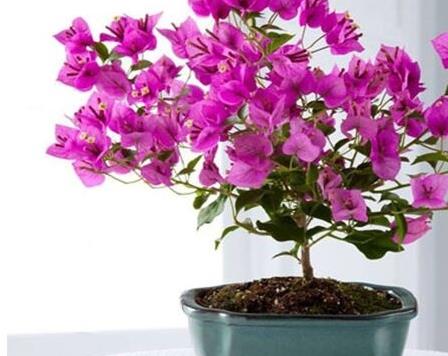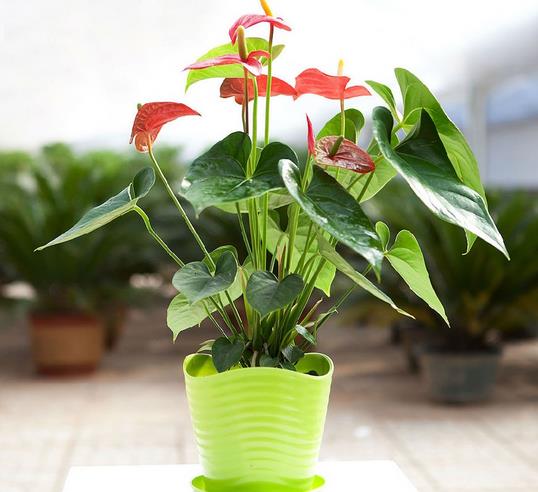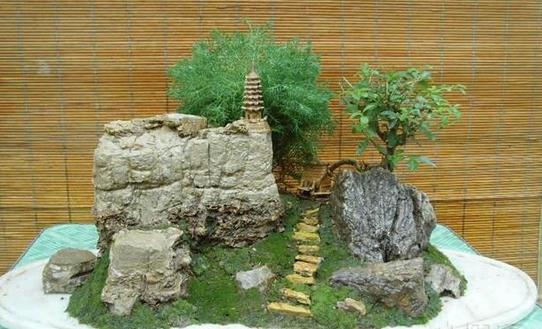Bonsai cultivation of leaf flower cultivation techniques
The appearance of the leaf flower is not amazing and goes unnoticed. The three flowers are often clustered in three larger bracts, and the pedicels are connate with the veins of the medicine tablets. The bracts are time-shaped, with bright red, orange, purplish red, milky white, etc., similar to gorgeous petals, hence the name leaf flower, triangular flower. On the occasion of winter and spring, colorful bracts are displayed, giving people an unrestrained and warm feeling. Next, the editor will introduce to you the cultivation and maintenance techniques of leaf flowers.
1. Prepare basin soil
The potted soil for the cultivation of leaf flowers requires a slightly acidic soil that is loose, fertile and well drained. Generally, it can be mixed with rotten leaf soil, peat soil, garden soil and sandy soil, and then mixed with a small amount of rotten cake residue or bone powder. The leaf flower grows rapidly, so it is necessary to change the pot and change the soil every 1-2 years, and the pot should be changed before sprouting in early spring.
2. Strengthen the lighting
The cultivated scarf flower is a positive tree species, the new branches grow weakly in insufficient light or in shady environment, the leaves are dim or shedding, and often do not blossom or blossom very little. Therefore, except for the new plants should be placed in the semi-shade to slow down the seedlings, the rest of the time should be put in a sunny place to cultivate.

Bonsai cultivation of leaf flower cultivation techniques
3. Water and fertilizer management
Leaf flower plant growth is exuberant, summer watering should be sufficient, usually once in the morning and evening every day. Water is watered once every evening in spring and autumn. If the temperature is low in winter and the plant is in a semi-dormant state, watering should be controlled, otherwise it is easy to cause rotting roots. Leaf flowers like fertilizer, so they can apply rotten thin pancake fertilizer and water every 15 days or so during the growth period. The application of available phosphate fertilizer for 2 or 3 times before flowering or extra-root fertilization is beneficial to bright flower color. After each fertilization, it is necessary to irrigate the water and loosen the soil in time, otherwise it is easy to cause rotting roots or yellowing leaves. Fertilization should be stopped in winter. Leaves and flowers are lianas. Vines can grow more than 10 meters
4. Shaping and pruning
The leaf flower is suitable for vertical greening, and the southern cultivation mainly takes the drooping growth type, that is, picking the heart at the seedling stage to promote the branches, each plant leaves 3-5 branches to make it droop and grow, and soon there are a lot of flowers on the inverted overhanging branches. Potted plants in the north need to be pruned in order not to grow into a vine. After flowering, the dense branches, slender branches and overgrown branches should be cut off from the base of the plant, and the retained branches should be about 30 cm long to cut off the top shoots. At the same time, all lateral branches should be cut short to promote the germination of new branches. In summer, new lateral branches are often easy to grow and should be plucked in time, while the branches with too dense inner chamber should be removed. If the potted leaf flower is not used for indoor climbing, it should be pruned after flowering to promote more new branches to grow into a spherical crown, and the old branches that have grown for 5 ~ 6 years should be renewed and rejuvenated in order to keep the plant shape beautiful.
5. Florescence regulation
The leaf flower is a short-day plant, and the suitable temperature for flowering is 20-25 ℃. It is often potted in the north. If you want to bloom on National Day, it should be shaded from around August 10, with only 10 hours of light every day, from 7 a.m. to 5 p.m., and the rest of the time with a black plastic cover. After 45-50 days, the flowers can bloom. In the process of shading, be sure to cover the plants tightly to prevent the light from passing through, because the leaves and flowers are sensitive to light, and as long as there is a weak light, the treatment will fail. When dealing with indoor shading, when the temperature exceeds 33 ℃, water should be sprinkled to cool down, doors and windows should be opened at night and ventilation should be carried out for 2-3 hours. Shading treatment should be carried out continuously, the middle can not be interrupted, the initial period of shading should be well mastered, and the bracts will be small and dark later. If it blossoms on May Day, it should be heated and the temperature should be controlled above 20 ℃. It can blossom in about 50 days.
Bonsai cultivation of leaf flower cultivation techniques
There are many famous flowers in the world, but the great poet Tao Yuanming only likes the lotus flowers that are unstained out of the mud. What about you? What kind of flower is the flower fairy in your mind? Someone once asked me such a question, my answer is: Ye Zihua. Yes, I am only in love with the clusters of foliage flowers embracing each other. I am intoxicated by her gorgeous colors. She is tasteless, but bright, but not ostentatious. Whenever I look at her, I feel as if she is my confidante. She knows what I think. We are all the same. We do not want to be surprised in the world, but only for the years to be quiet.
The appearance of the leaf flower is not amazing and goes unnoticed. The three flowers are often clustered in three larger bracts, and the pedicels are connate with the veins of the medicine tablets. The bracts are time-shaped, with bright red, orange, purplish red, milky white, etc., similar to gorgeous petals, hence the name leaf flower, triangular flower. On the occasion of winter and spring, colorful bracts are displayed, giving people an unrestrained and warm feeling. Next, Tuba Rabbit introduces the cultivation and conservation techniques of leaf flower for you:
1. Prepare basin soil
The potted soil for the cultivation of leaf flowers requires a slightly acidic soil that is loose, fertile and well drained. Generally, it can be mixed with rotten leaf soil, peat soil, garden soil and sandy soil, and then mixed with a small amount of rotten cake residue or bone powder. The leaf flower grows rapidly, so it is necessary to change the pot and change the soil every 1-2 years, and the pot should be changed before sprouting in early spring.
2. Strengthen the lighting
The cultivated scarf flower is a positive tree species, the new branches grow weakly in insufficient light or in shady environment, the leaves are dim or shedding, and often do not blossom or blossom very little. Therefore, except for the new plants should be placed in the semi-shade to slow down the seedlings, the rest of the time should be put in a sunny place to cultivate.
3. Water and fertilizer management
Leaf flower plant growth is exuberant, summer watering should be sufficient, usually once in the morning and evening every day. Water is watered once every evening in spring and autumn. If the temperature is low in winter and the plant is in a semi-dormant state, watering should be controlled, otherwise it is easy to cause rotting roots. Leaf flowers like fertilizer, so they can apply rotten thin pancake fertilizer and water every 15 days or so during the growth period. The application of available phosphate fertilizer for 2 or 3 times before flowering or extra-root fertilization is beneficial to bright flower color. After each fertilization, it is necessary to irrigate the water and loosen the soil in time, otherwise it is easy to cause rotting roots or yellowing leaves. Fertilization should be stopped in winter. Leaves and flowers are lianas. Vines can grow more than 10 meters
4. Shaping and pruning
The leaf flower is suitable for vertical greening, and the southern cultivation mainly takes the drooping growth type, that is, picking the heart at the seedling stage to promote the branches, each plant leaves 3-5 branches to make it droop and grow, and soon there are a lot of flowers on the inverted overhanging branches. Potted plants in the north need to be pruned in order not to grow into a vine. After flowering, the dense branches, slender branches and overgrown branches should be cut off from the base of the plant, and the retained branches should be about 30 cm long to cut off the top shoots. At the same time, all lateral branches should be cut short to promote the germination of new branches. In summer, new lateral branches are often easy to grow and should be plucked in time, while the branches with too dense inner chamber should be removed. If the potted leaf flower is not used for indoor climbing, it should be pruned after flowering to promote more new branches to grow into a spherical crown, and the old branches that have grown for 5 ~ 6 years should be renewed and rejuvenated in order to keep the plant shape beautiful.
5. Florescence regulation
The leaf flower is a short-day plant, and the suitable temperature for flowering is 20-25 ℃. It is often potted in the north. If you want to bloom on National Day, it should be shaded from around August 10, with only 10 hours of light every day, from 7 a.m. to 5 p.m., and the rest of the time with a black plastic cover. After 45-50 days, the flowers can bloom. In the process of shading, be sure to cover the plants tightly to prevent the light from passing through, because the leaves and flowers are sensitive to light, and as long as there is a weak light, the treatment will fail. When dealing with indoor shading, when the temperature exceeds 33 ℃, water should be sprinkled to cool down, doors and windows should be opened at night and ventilation should be carried out for 2-3 hours. Shading treatment should be carried out continuously, the middle can not be interrupted, the initial period of shading should be well mastered, and the bracts will be small and dark later. If it blossoms on May Day, it should be heated and the temperature should be controlled above 20 ℃. It can blossom in about 50 days.
Do you love all the flowers in the world, or do you love only one? I believe there are many people like me who are in love with Ye Zihua. Some foliage flowers spread on the fence, colorful; some set up in the forest, unique; some were trimmed into bonsai seclusion indoors, full of charm. Pot cultivation of leaf flowers requires certain methods and skills, the above methods can be used for reference, if you want to know more about leaf flower cultivation techniques, click to pay attention to Tuba Rabbit, we will provide you with a satisfactory answer.
Bonsai cultivation techniques (1) the relationship between potted flowers and environment plants 1. The relationship between potted flowers and environment the living environment of plants is soil, water, light and temperature. Potted flowers are no exception. (1) soil: soil is an indispensable basis for the survival of every kind of plant, especially the vast majority of potted flowers need soil rich in a variety of minerals. Generally speaking, there are three types of soil: acidic soil (PH value less than 7), neutral soil (PH value equal to 7) and alkaline soil (PH value greater than 7). In the south, most of the flowers are acidic and neutral, while those of alkaline soil are few. The soil PH value of potted flowers in South China is generally between 5.5 and 6.5, and the flowers grow well. (2) temperature and light: due to the different distribution of plants at different elevations, the suitable growth area (community environment) of each kind of plant is formed, and the temperature, humidity and light hours required by flowers are also different with different community environment. False betel nut, banma, mangrove and rich trees introduced from the tropics to the subtropics are suitable for indoor and outdoor cultivation in the tropics and move to the subtropics. Due to the strong irradiation of ultraviolet money, they are easy to burn in summer, and are easy to be damaged by frost in winter. Unable to survive the winter in the wild, must be moved into the greenhouse or indoor. (3) Water: water is the lifeblood of plants, and each plant has different needs for water. For example, the three major families of Orchidaceae, Tea Family and Gramineae, some plants in each family need similar water, but they are different from the major families. Orchid plants are negative flowers and tea plants are semi-negative. The demand for water of flowers in these two families is less than that of Gramineae. Most of Gramineae flowers and plants are positive flowers. Kone different varieties of flowers and plants have different moisture requirements. 2. Classification of potted flowers potted flowers in Yiliang can be roughly divided into three types according to their biological characteristics and commercial production requirements: positive flowers, negative flowers and neutral flowers. (1) positive flowers: generally can grow healthily under strong light. Such as: triangular plum (i.e. leaf flower) more than 10 species, white orchid (Burma sweet-scented osmanthus), sweet-scented osmanthus (3 species), arrow lotus (2 species), crab orchid, cactus (3 species), cactus, Milan, banana Michelia, southern fir, yellow poplar (4 species), rose (more than 10 species), rose (4 species), five needle pine, dragon cypress, autumn chrysanthemum (105 species), Ziteng (2 species), cherry blossom (3 species), winter cherry blossom (Xiao Yang Chun), Jiexiang, Jiexiang. Tiger plum, Jiuli incense, magnolia (3 species), German orchid (2 species), Phyllostachys pubescens, Yingchuhua, poinsettia, a string of red, cypress (6 species), gardenia (2 species), bamboo sunflower (5 species), Chinese carnation, carnation, carnation (7 species), bamboo (5 species), Persian chrysanthemum, black heart chrysanthemum, marigold (3 species), calendula, canna, American carnation (5 colors) Fusang (3 species), fragrant snow orchid, sorrel (2 species), bubble flower, woody full star, silk orchid, mountain magnolia, Damu orchid, loquat, rose (5 species), safflower magnolia, plum, potted orange, Portuguese cypress, red coral, juniper, green peach, rescue army grain, hypericum, pomegranate (5) and so on. (2) negative flowers: generally, they can grow and develop normally under the condition of low light with a shade degree of more than 50%. Such as: spring taro, tortoise back bamboo, false betel nut (Yiliang only), fragrant dragon blood tree (Yiliang only), fruit taro (red and emerald), green apple, green velvet, mountain dragon, rich bamboo, bean petal green, crane orchid, cyclamen (various), Saxifraga, hanging bamboo plum, primrose, melon leaf chrysanthemum, seven-leaf tree (only suitable for Liang), rich tree, palm bamboo (3 species), goose palm wood, Belgian rhododendron, calla lily, fern (various), Begonia, dry high autumn, camellia, begonia, sunflower (needle sunflower), sunflower, taro and so on. (3) there is little relationship between neutral flowers and light intensity, such as tea plum (2 species), June snow, Xiuqiu, winter coral, violet, rhododendron (except Belgian rhododendron), iron tree (5 species), wind fairy flower, Tianmeng, wheat how to plant grass, butterfly vine, ivy (3 species), Luohansong, etc., neutral flowers between positive flowers and negative flowers, is relatively speaking, it has nothing to do with light.
- Prev

Hydroponic Anthurium andraeanum cultivation method makes your indoor potted plant more beautiful
Anthurium andraeanum is not only a plant of Araceae, but also a kind of hydrophilic plant. But hydroponics is a little more difficult. So how to grow Anthurium andraeanum in hydroponic culture? How much do you know? Next, let me give you a detailed introduction to how to grow Anthurium andraeanum in water culture. Culture method of hydroponic Anthurium andraeanum
- Next

Matters needing attention in miniature bonsai cultivation
Art is a kind of value. in the past, many people only knew how to make money, but did not know how to enjoy it, but it was obviously different from people now. now many industries in society are very particular about art, and they pay attention to the location of art in the development of every new product. After so many digressions, let's get to the point.
Related
- Fuxing push coffee new agricultural production and marketing class: lack of small-scale processing plants
- Jujube rice field leisure farm deep ploughing Yilan for five years to create a space for organic food and play
- Nongyu Farm-A trial of organic papaya for brave women with advanced technology
- Four points for attention in the prevention and control of diseases and insect pests of edible fungi
- How to add nutrient solution to Edible Fungi
- Is there any good way to control edible fungus mites?
- Open Inoculation Technology of Edible Fungi
- Is there any clever way to use fertilizer for edible fungus in winter?
- What agents are used to kill the pathogens of edible fungi in the mushroom shed?
- Rapid drying of Edible Fungi

